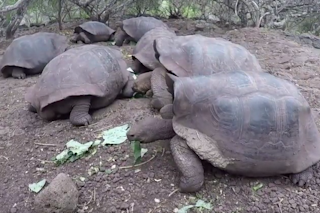A tortoise's shell shape can help determine how quickly it can turn right side up after falling on its back. (Credit: YouTube/Bio Insider) It’s tough being an adult giant tortoise in the Galapagos Islands—they’re always one step away from flipping upside down. Whether it’s from a fight for male dominance or treading over a jagged field of lava rocks, being unable to get back up is among the most common ways these giant tortoises can die. There is no Life Alert button to press for help. Instead, these animals must rely on their ability to flip over and keep on living. Luckily, many Galapagos tortoises are successful at doing so. It’s referred to as “self-righting,” and is the focus of a new study published Thursday in Nature Scientific Reports. Ylenia Chiari, an evolutionary biologist at the University of South Alabama, led a group of scientists that tested several tortoise shell ...
Shell Shape Helps Tortoises Get Up
Discover how Galapagos tortoises self-righting abilities differ between shell types, impacting their survival.

Newsletter
Sign up for our email newsletter for the latest science news

Matt Benoit
Matt Benoit is a journalist based in Bellingham, Washington. His work has appeared in several Washington newspapers, the Pacific Northwest Inlander, Salish Current, WhatcomTalk.com and Freethink Media. He believes learning and curiosity are fundamental to a good life. Find him on X.View Full Profile
More on Discover
Stay Curious
SubscribeTo The Magazine
Save up to 40% off the cover price when you subscribe to Discover magazine.
Subscribe












